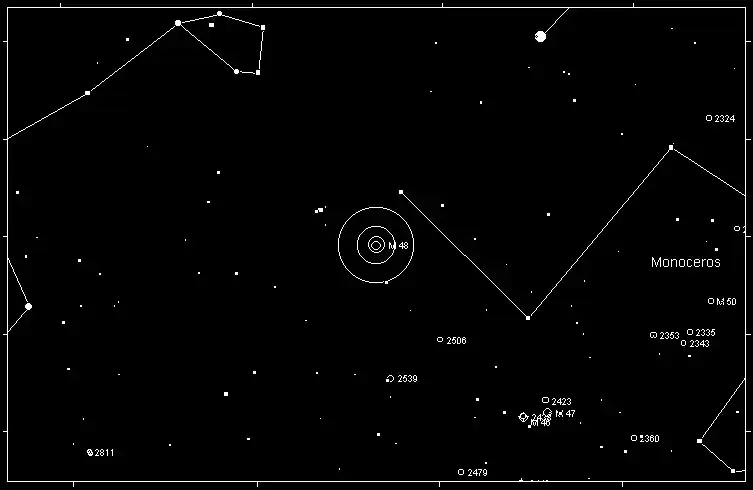Messier 48 (M48) is an open star cluster located in the constellation Hydra. It is one of the many objects cataloged by the French astronomer Charles Messier in the 18th century. Although it is relatively easy to find with a small telescope or binoculars, M48 was mistakenly omitted from Messier’s original list due to a slight error in its recorded position. This bright and sprawling cluster is an intriguing target for amateur astronomers, especially during the spring months.
Description and Magnitude
Messier 48 is an open cluster, meaning it consists of a group of stars that were formed together from the same molecular cloud and are loosely bound by mutual gravitational attraction. The cluster is located about 1,500 light-years from Earth and spans approximately 23 light-years across.
M48 has an apparent magnitude of 5.5, making it one of the brighter open clusters in the night sky. Under dark skies, it is visible to the naked eye as a faint smudge of light, but it is best observed through binoculars or a small telescope, which can reveal individual stars within the cluster. The cluster contains around 80 stars, with the brightest members shining at magnitude 8 to 10.

Prominent Season and Constellation
Messier 48 is located in the constellation Hydra, the Water Serpent, which is the largest constellation in the sky. The best time to observe M48 is during late winter and early spring when Hydra is prominently visible in the southern sky. In the Northern Hemisphere, this period typically spans from February to May. During these months, M48 can be seen well above the horizon in the evening, making it an ideal target for observation.
How to Find Messier 48
Finding Messier 48 is relatively straightforward due to its location and brightness. The cluster is positioned about 14 degrees east-southeast of the bright star Procyon in the constellation Canis Minor, which can serve as a useful guidepost.
To locate M48:
- Start with Procyon: Begin by locating Procyon, the brightest star in Canis Minor. It is easy to spot as it is one of the prominent stars forming the Winter Triangle, alongside Betelgeuse in Orion and Sirius in Canis Major.
- Move Southeast: From Procyon, move your telescope approximately 14 degrees to the east-southeast. This distance is roughly equal to the width of a fist held at arm's length.
- Scan the Area: As you approach the area, slowly scan the region to locate a group of stars that appear denser than the surrounding field. This is Messier 48.
- Adjust and Focus: Once you've located the cluster, fine-tune your telescope's focus to bring out the details of the individual stars within M48. You should see a scattering of stars with no central concentration, characteristic of an open cluster.

History of Messier 48
Messier 48 was discovered by Charles Messier on February 19, 1771. Messier, a French astronomer known for his catalog of "nebulae and star clusters," initially recorded its position incorrectly, leading to some confusion among astronomers in later years. The cluster was independently rediscovered by Caroline Herschel in 1783 and was later confirmed to be the same object that Messier had cataloged.
Due to the initial position error, M48 was not identified correctly in the Messier catalog until the 20th century. In 1934, the amateur astronomer Oswald Thomas correctly identified NGC 2548 as Messier 48, resolving the longstanding confusion.
Conclusion
Messier 48 is a stunning open cluster that offers a rewarding experience for stargazers. Whether viewed through binoculars or a telescope, the cluster's scattered stars present a beautiful sight against the backdrop of the vast constellation Hydra. As one of the easier Messier objects to locate, M48 serves as an excellent introduction to deep-sky observing, inviting both novice and experienced astronomers to explore its youthful stars and rich history.
